 |
| इयत्ता आठवी इतिहास धडा सामाजिक आणि धार्मिक सुधारणा मराठी स्वाध्याय PDF |
या लेखात, आम्ही इतिहास धडा सामाजिक आणि धार्मिक सुधारणा विषयासाठी इयत्ता आठवी मराठी सोल्यूशन्स देऊ. इयत्ता आठवी मधील विद्यार्थी पाठ्यपुस्तकांमध्ये उपस्थित असलेल्या व्यायामांसाठी प्रश्न आणि उत्तरे डाउनलोड आणि कॉपी करण्यास सक्षम असतील.
इयत्ता आठवी इतिहास धडा सामाजिक आणि धार्मिक सुधारणााच्या पुस्तकात महाराष्ट्र बोर्डाच्या अभ्यासक्रमातील सर्व प्रश्नांचा समावेश आहे. येथे सर्व प्रश्न पूर्ण स्पष्टीकरणासह सोडवले आहेत आणि डाउनलोड करण्यासाठी विनामूल्य उपलब्ध आहेत. महाराष्ट्र बोर्ड इयत्ता आठवी इतिहास धडा सामाजिक आणि धार्मिक सुधारणााचे पुस्तक खाली दिले आहे. आम्हाला आशा आहे की आमच्या इयत्ता आठवी वीच्या इतिहास धडा सामाजिक आणि धार्मिक सुधारणााचे पुस्तक तुमच्या अभ्यासात मदत करेल! जर तुम्हाला आमचे इयत्ता आठवी चे पुस्तक आवडले असेल तर कृपया ही पोस्ट शेअर करा.
इयत्ता आठवी इतिहास धडा सामाजिक आणि धार्मिक सुधारणा स्वाध्याय
|
मंडळाचे नाव |
Maharashtra Board |
|
ग्रेडचे नाव |
आठवी |
|
विषय |
इतिहास धडा सामाजिक आणि धार्मिक सुधारणा |
|
वर्ष |
2022 |
|
स्वरूप |
PDF/DOC |
|
प्रदाता |
|
|
अधिकृत संकेतस्थळ |
mahahsscboard.in |
समाधानासह महाराष्ट्र बोर्ड आठवा स्वाध्याय कसे डाउनलोड करायचे?
महाराष्ट्र बोर्ड आठवी स्वाध्याय PDF डाउनलोड करण्यासाठी खालील स्टेप्स फॉलो करा:
- वेबसाइट- Hsslive ला भेट द्या. 'स्वाध्याय' लिंकवर क्लिक करा.
- महा बोर्ड आठवी स्वाध्याय PDF पहा.
- आता महाराष्ट्र बोर्ड आठवी स्वाध्याय तपासा.
- डाउनलोड करा आणि भविष्यातील संदर्भांसाठी जतन करा.
इयत्ता आठवी इतिहास धडा सामाजिक आणि धार्मिक सुधारणा स्वाध्याय उपाय
इयत्ता आठवी स्वाध्याय मधील विद्यार्थी खालील लिंक्सवरून इतिहास धडा सामाजिक आणि धार्मिक सुधारणााचे उपाय डाउनलोड करू शकतील.
Class 8 History Chapter 5 Social and Religious Reforms Textbook Questions and Answers
1. Rewrite the statements by choosing the appropriate options:
(Sir Sayyad Ahmad Khan, Maharshi Dhondo Karve, Abdul Latif, Swami Vivekananda, Maharshi Vitthal Ramji Shinde)
Question 1.
………….. established the Ramkrishna Mission.
Answer:
Swami Vivekananda
Question 2.
The Anglo-Mohammedan Oriental College was established by………….. .
Answer:
Sir Sayyad Ahmad Khan
Question 3.
The Depressed Classes Mission was founded by ……………. .
Answer:
Maharshi Vitthal Ramji Shinde
2. Complete the following table:
Question 1.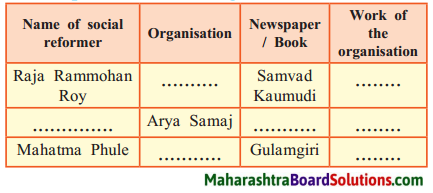
Answer: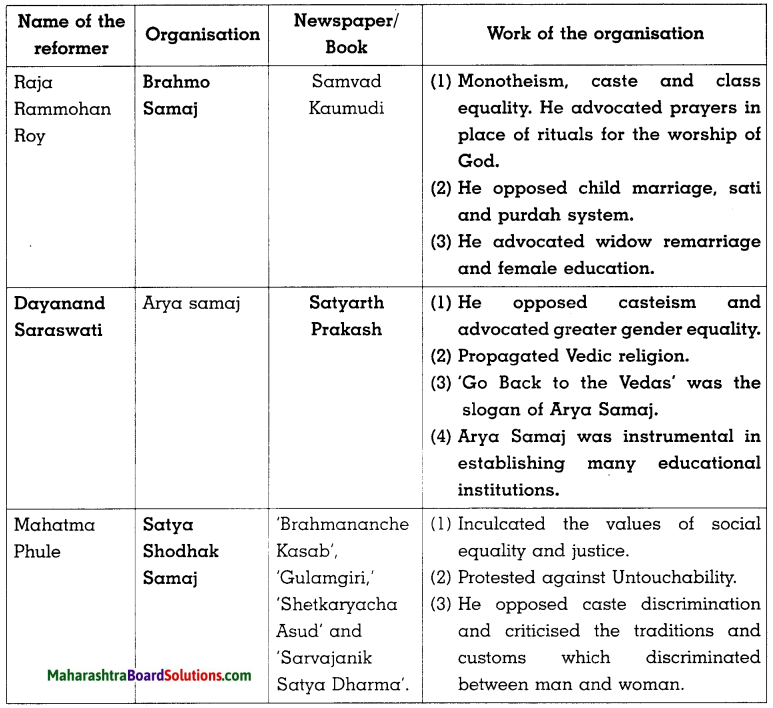
3. Explain the following statements with reasons:
Question 1.
The social and religious reform movement began in India.
Answer:
- With the spread of English education in India, there was spread of new ideas, new thoughts, new philosophy.
- Indians got introduced to western thoughts and culture.
- They wanted to create a society based on principles of Humanity, Equality and Fraternity.
- They realised that the flaws like superstitions, casteism, old customs, class system and lack of critical outlook is responsible for the backwardness of India.
- This association was responsible for social and religious reform in India.
Question 2.
Mahatma Phule conducted a strike of Barbers.
Answer:
- There was a custom of Keshavapan, i.e. shaving head of widows in India.
- In order to oppose this unjust custom, Mahatma Phule conducted a strike of Barbers.
4. Write short note:
Question 1.
Ramkrishna Mission :
Answer:
- Swami Vivekananda, a close disciple of Ramkrishna Paramhansa, founded the Ramkrishna Mission in 1897.
- The mission carried out social work like providing help to famine-stricken people, patients and gave medical help to the poor and worked for female education.
- It taught people service to humanity is a true religion and worked towards spiritual progress of the people.
Question 2.
Reforms for women by Savitribai Phule:
Answer:
- Savitribai Phule, wife of Mahatma Phule, advocated women’s education along with him.
- She supported her husband in his efforts to start first school for girls at Bhide Wada in Pune.
- She continued her work in the field of education though she faced severe criticism from the society.
- She put great efforts in women reform movement which resulted in putting an end to many unjust practices.
Do you know?
Renaissance in other fields/areas :
| Sr. No. | Field/ Area | Changes/Progress |
| 1. | Literature | 1) Stories and novels dealt with the themes related with social reforms. Writing by women authors. 2) Newspapers and magazines became the carriers of social reform and political awakening. |
| 2. | Art | 1) Music became people-oriented. 2) Traditional Indian style of painting was combined with western techniques. |
| 3. | Science | 1) Writing of books on science emphasized scientific outlook. 2) People realised the importance of experimentation and scientific outlook for progress. |
Project:
Question 1.
Organise an essay competition on the topic ‘Education of women’.
Question 2.
Collect the paragraphs of social reformers.
Class 8 History Chapter 5 Social and Religious Reforms Additional Important Questions and Answers
Rewrite the statements by choosing the appropriate options:
(Sir Sayyad Ahmad Khan, Maharshi Dhondo Karve, Abdul Latif, Swami Vivekananda, Maharshi Vitthal Ramji Shinde)
Question 1.
Through the efforts of ……….. first women’s university was set up in the 20th century.
Answer:
Maharshi Dhondo Karve
Question 2.
………….. established The Mohammedan Literary Society in Bengal.
Answer:
Abdul Latif.
Name the following :
Question 1.
He founded Hindu College at Kolkata.
Answer:
Raja Rammohan Roy
Question 2.
First president of Prarthana Samaj.
Answer:
Dr. Atmaram Pandurang Tarkhadkar
Question 3.
‘Go Back to the Vedas’ was the slogan of this Institution.
Answer:
Arya Samaj
Question 4.
He represented Hinduism at the Parliament of Religions at Chicago in 1893.
Answer:
Swami Vivekananda.
Identify the wrong pair:
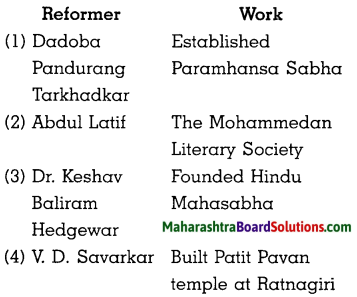
Answer:
Wrong pair: Dr. Keshav Baliram
Hedgewar – Founded Hindu Mahasabha
Corrected pair: Dr. Keshav Baliram
Hedgewar – founded Rashtriya
Swayam- Sevak Sangh.
Rewrite the statements by choosing the appropriate options:
Question 1.
Raja Rammohan Roy helped Governor General ……… to pass the Sati Prohibition Act.
(a) Lord Wellesley
(b) Lord Bentinck
(c) Robert Clive
(d) Lord Cornwallis
Answer:
Lord Bentinck
Question 2.
Gopal Ganesh Agarkar gave his staunch opinion about child marriage, law of consent in his newspaper ………… .
(a) Maratha
(b) Darpan
(c) Sudharak
(d) Dnyanoday
Answer:
Sudharak
Question 3.
……….. started the Nursing Course for Women through Seva Sadan Institute.
(a) Tarabai Shinde
(b) Ramabai Ranade
(c) Savitribai Phule
(d) Pandita Ramabai
Answer:
Ramabai Ranade
Question 4.
………… continued tradition of reformation in Sikh religion.
(a) Singh Sabha
(b) Akali movement
(c) Arya Samaj
(d) Prarthana Samaj
Answer:
Akali movement
Question 5.
Lokhitwadi advocated gender equality through his writings in ………… .
(a) Sudharak
(b) Kesari
(c) Shatpatre
(d) Darpan
Answer:
(c) Shatpatre
Do as Directed:
Complete the concept map:
Question 1.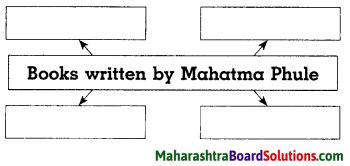
Answer: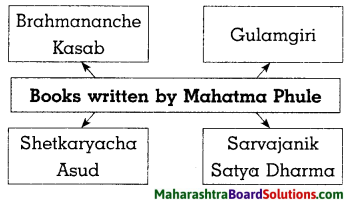
Question 2.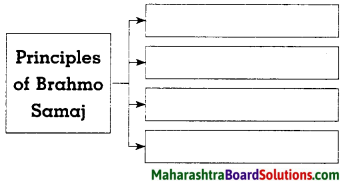
Answer: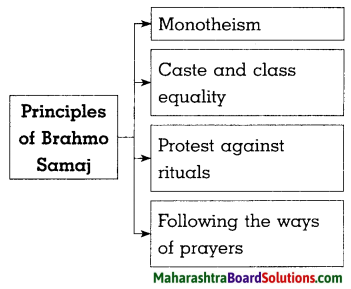
Question 3.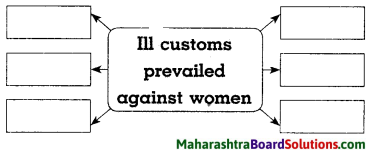
Answer: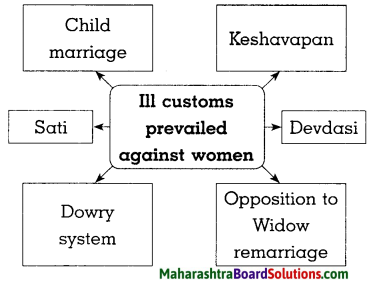
2. Complete the timeline:

Answer:
Answer the following in one sentence each :
Question 1.
What message was given by Swami Vivekanand to the Indian youth?
Answer:
‘Arise, Awake and stop not till the goal is achieved’ was the message given by Swami Vivekanand to the Indian youth.
Question 2.
Write about the work of Singh Sabha.
Answer:
The Singh Sabha worked to achieve reforms, to spread education among the Sikh community and bring in modernisation among them
Question 3.
What were the principles of Prarthana Samaj?
Answer:
The opposition to idol worship, monotheism and opposition to rituals were the principles of Prarthana Samaj.
Question 4.
Which social reformers worked for the cause of widow remarriage?
Answer:
Pandit Ishwarchandra Vidyasagar, Vishnushastri Pandit and Vireshlingam Pantalu worked for the cause of widow remarriage.
Question 5.
Who started ‘Anath Balikashram’?
Answer:
Maharshi Dhondo Keshav Karve started Anath Balikashram, an orphanage for girls, to give education to all women so that they become independent.
Question 6.
Who received the Nobel Prize and in which field?
Answer:
Rabindranath Tagore received Nobel in the field of literature and C. V. Raman for Science.
Question 7.
What was The Mohammedan Anglo Oriental College later known as?
Answer:
The Mohammedan Anglo Oriental College was later known as the Aligarh Muslim University.
Write short note:
Question 1.
Prarthana Samaj :
Answer:
(1) Paramhansa Sabha was dissolved and some of its members formed Prarthana Samaj.
(2) Dr. Atmaram Pandurang was its first President.
(3) They opposed idol worship, monotheism and advocated prayers and devotional songs instead of rituals in place of worship of God.
(4) The important contribution of Prarthana Samaj in reforming the society was that it started orphanages, women’s education institutes, night schools for workers and society for Dalits.
(5) The prestige of Prarthana Samaj rose immensely due to the enrollment of young graduates from Mumbai University.
(6) Justice Ranade, Dr. R. G. Bhandarkar carried the work of Prarthana Samaj forward.
Question 2.
Sir Sayyad Ahmed Khan :
Answer:
- Sir Sayyad Ahmad Khan worked for the cause of Muslims.
- He believed that the Muslims would not make progress without acquiring western education and science.
- He founded ‘The Mohammedan Anglo Oriental College’ which later became Aligarh Muslim University.
Answer the following in 25 to 30 words:
Question 1.
Write about the contribution of Maharshi Vitthal Ramji Shinde.
Answer:
- Maharshi Vitthal Ramji Shinde was member of Prarthana Samaj, contributed in reforming society.
- He started the ‘Depressed Class Mission’.
- He tried to solve problems in society through this mission.
- He organised conference against the practice of Devdasi in Mumbai.
Question 2.
Write about the efforts taken to unite Hindu Society.
Answer:
- Hindu Mahasabha was formed in 1915 to achieve respectful position of Hindu community and protect it.
- Pandit Madan Mohan Malviya founded the ‘Banaras Hindu University’.
- Dr. Keshav Baliram Hedgewar established Rashtriya Swayamsevak Sangh in 1925 at Nagpur to set up a disciplinary and virtuous organisation of Hindu youth.
- Patit Pawan Temple built by V. D. Savarkar at Ratnagiri was open to all castes of Hindu religion. He also organized common dining programmes.
Question 3.
Give a brief account of the work of women social reformers for the emancipation of women.
Answer:
The women reformers contributed in the following way to improve the condition of women :
- Savitribai Phule faced severe criticism of society but continued her work in the field of education.
- Tarabai Shinde wrote the book ‘Stri Purush Tulana’ in which she fiercely put her views about the rights of women.
- Pandita Ramabai founded the Sharada Sadan and took care of disabled women and children.
- Ramabai Ranade founded the Seva Sadan Institute. She started the Nursing course for women as well as demanded the right to vote for them.
Question 4.
State the outcome of women reform movement.
Answer:
- The women’s reforms movement resulted in putting an end to many unjust practices in the society.
- They voiced their problems and made efforts to find solution to them.
- The women got opportunities to prove their capabilities in different fields.
- Women started expressing their ideas, thoughts through writing.
- Their performance flourished in every sphere of life due to education.
Question 5.
What changes came about in the field of Science, Art and Literature during Indian Renaissance?
Answer:
The following changes were seen in the field of Science, Art and Literature during Indian Renaissance :
(A) Science :
- C. V. Raman received the Nobel Prize in Science.
- Many books were written on science which emphasized scientific outlook.
- People realised the importance of experimentation and scientific outlook for progress of the country.
(B) Art :
- Music became more popular and people-oriented.
- A new school of painting combining traditional Indian style of painting with the western techniques emerged.
(C) Literature :
- Rabindranath Tagore received the Nobel Prize in literature.
- Stories and novels gave inspiration in gaining independence and expressed thoughts on social reforms.
- Women took to writing.
- New magazines and newspapers became sources of inspiration and political awakening.
Write short note :
Question 1.
The condition of women was miserable in the beginning of nineteenth century.
Answer:
The condition of women during the British period was very miserable in India, because :
- They had no right to education.
- There was no equality between men and women.
- Women were victims of child marriage, dowry system, sati, Keshavapan, opposition to widow remarriage.
Answer the following in detail :
Question 1.
Write briefly about Indian Renaissance.
Answer:
1. The modern educated Indians realised that the unhealthy social conditions and customs like casteism, superstitions, old customs, class system and lack of critical outlook had arrested the progress of India.
2. Rise in the spread of new ideas, new thoughts, new philosophy marked the beginning of modern age.
3. It was necessary to eradicate the flaws and undesirable tendencies in order to create a new society based on principles of Humanity, Equality and Fraternity.
4. They started finding new ways for development of society and country. Educated thinkers started social awareness through writings.
5. This intellectual awakening in the contemporary society in India is called the Indian Renaissance.
Question 2.
Give a brief account of the work of social reformers for the betterment of women.
Answer:
- Raja Rammohan Roy launched agitations against practice of Sati.
- It led to the enactment of the Sati Prohibition Act in 1829.
- He advocated widow remarriage and female education and opposed Purdah system.
- Gopal Hari Deshmukh (Lokhitwadi) criticized the unjust social customs related to women and advocated equality of men and women through his writings in ‘Shatapatre’.
- Mahatma Phule gave importance to 2 girl’s education. He started first school for i girls at Bhide Wada in Pune.
- Through his writings Babasaheb Ambedkar exposed injustice inflicted on women.
- Mahatma Gandhi advocated education for women.
- Ishwar Chandra Vidyasagar, Vishnushastri Pandit and Vireshlingam Pantalu strove for the recognition of the right to remarriage for the widows.
- Gopal Ganesh Agarkar gave his staunch opinion about child marriage and j law of consent in his newspaper ‘Sudharak’.
- Maharshi Vitthal Ramji Shinde organised a conference to oppose practice of Devdasi.
- Maharshi Dhondo Keshav Karve founded the Anath Balikashram for orphan girls and later the first Women’s University.
Question 3.
What would have happened if social reformers had not taken initiative for women education?
Answer:
We have seen many social reformers in the last 100-150 years. They not only insisted on women education but also took efforts to make it reality.
If they had not taken efforts towards women education then:
- Women would have still remained illiterate and would have easily fallen prey to superstitions.
- They would have to carry burden of age old customs and traditions.
- Illiterate women could not contribute to the development of family, society and nation.
- Today they work hand in hand with their male counterparts because they are educated.
Question 4.
What changes have been made in the life of women due to education?
Answer:
Education has brought lot of changes in the life of women.
- Women started taking jobs, doing business which made them financially independent.
- They are working and competing along with men in every field.
- Educated women freed themselves from the clutches of superstitions.
- Educated women have become strong enough to face the injustice of society.
- The principle of equality is put into practice because of their education.
- As woman got educated she contributed for development of her family and country.
Question 5.
Do you still feel there is need to make efforts for women’s education? If yes, then what efforts need to be made?
Answer:
- I feel we still need to make efforts on girls’ education because among illiterates and less educated the number of women is more.
- The number of illiterate girls in rural and tribal areas is more.
- It is important to explain importance of girls’ education. Reforms are still required.
- To make people understand the benefit of girls’ education, documentaries and advertisements should be made.
- We need to take help of modern technology to achieve it.
इयत्ता आठवी इतिहास स्वाध्याय उपाय
- इयत्ता आठवी इतिहास धडा इतिहास स्रोत मराठी स्वाध्याय PDF
- इयत्ता आठवी इतिहास धडा युरोप आणि भारत मराठी स्वाध्याय PDF
- इयत्ता आठवी इतिहास धडा ब्रिटिश राजवटीचे परिणाम मराठी स्वाध्याय PDF
- इयत्ता आठवी इतिहास धडा 1857 चा स्वातंत्र्य लढा मराठी स्वाध्याय PDF
- इयत्ता आठवी इतिहास धडा सामाजिक आणि धार्मिक सुधारणा मराठी स्वाध्याय PDF
- इयत्ता आठवी इतिहास धडा स्वातंत्र्य चळवळीची सुरुवात मराठी स्वाध्याय PDF
- इयत्ता आठवी इतिहास धडा असहकार चळवळ मराठी स्वाध्याय PDF
- इयत्ता आठवी इतिहास धडा सविनय कायदेभंग चळवळ मराठी स्वाध्याय PDF
- इयत्ता आठवी इतिहास धडा स्वातंत्र्याच्या लढ्याचा शेवटचा टप्पा मराठी स्वाध्याय PDF
- इयत्ता आठवी इतिहास धडा सशस्त्र क्रांतिकारी चळवळ मराठी स्वाध्याय PDF
- इयत्ता आठवी इतिहास धडा समानतेसाठी संघर्ष मराठी स्वाध्याय PDF
- इयत्ता आठवी इतिहास धडा भारताला स्वातंत्र्य मिळाले मराठी स्वाध्याय PDF
- इयत्ता आठवी इतिहास धडा स्वातंत्र्यासाठी संघर्षाची पूर्तता मराठी स्वाध्याय PDF
- इयत्ता आठवी इतिहास धडा महाराष्ट्र राज्याची निर्मिती मराठी स्वाध्याय PDF






0 Comments:
Post a Comment